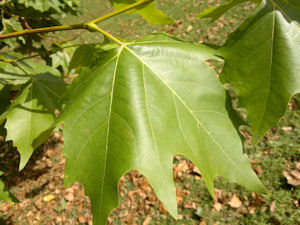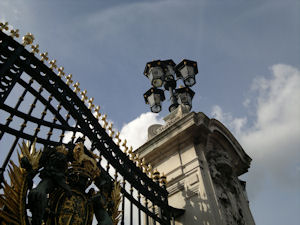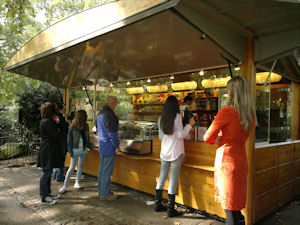Review: Nokia N8: part 1, overview and hardware
The retail version of the Nokia N8 (and first retail firmware) is finally here and I have been exploring it intensively over the last few days. Read on for what I liked (and didn't like) about the N8 hardware and overall interface. With Symbian^3 under the hood, as well as a truck load of Nokia-written additions, there's a lot to explore though, and this is is just part 1 of a multi-part review. Watch this space for much, much more on the Nokia N8, as the vanguard of a new range of smartphones from Nokia as well as being a camera phone extraordinaire....
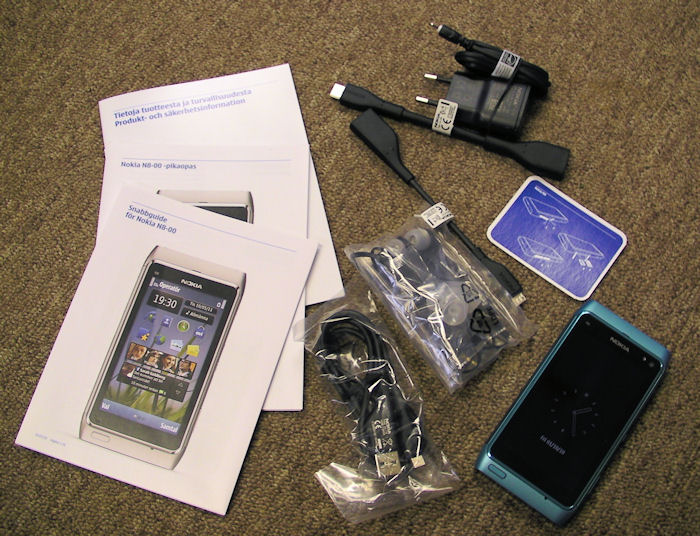
Every once in a while, we get to review a sea-change device here on All About Symbian. There was the first S60 3rd Edition phone - the Nokia N80, there was the famous N95, the first to run S60 3rd Edition Feature Pack 1 and with every bell and whistle then known to man onboard, there was the 5800, the first S60 5th Edition touch-driven phone running on Symbian OS. In each case, tackling a review was somewhat daunting, since there's so much that's new. Quite literally, where do you start?
At the end, funnily enough. We now have the final retail package and device, with launch firmware, so let's summarise the Nokia N8 in a single sentence.
The Nokia N8, along with Symbian^3 under the hood, fixes most of what was annoying about all of Nokia's previous S60 5th Edition phones, brings multimedia in line with the Android and iOS smartphones, and has the added bonus of super hardware and the hands-down best camera and camcorder ever put into a phone.

That summary sentence said, the N8's by no means perfect - the non-replaceable 1200mAh battery (unless you're handy with a Torx screwdriver and have read the instructions) means saying goodbye to the traditional Nokia flexibility of being able to carry a spare for emergencies. As a result, really heavy users will need to carry a mains or mobile charger instead and top-up when needed. I'll report back on the actual battery life achieved per charge after I've used it day in and day out for a week or two - Symbian^3 and the new chipset do promise better overall battery life and, in my testing so far, this is borne out.
Slightly worrying, especially in view of the camera pretensions, is that the 12 megapixel camera glass is both relatively exposed and unprotected by a mechanical protector. The exterior glass is 'toughened' (one of Nokia PR's proto N8s had seen regular use every day for 3 months and the glass was still pristine), but fingerprints/grease/dust will still cause problems, especially when shooting with the Xenon flash or into the sun outdoors. Having to wipe the glass of fingerprint grease before every important photo or video is a bit of a pain.
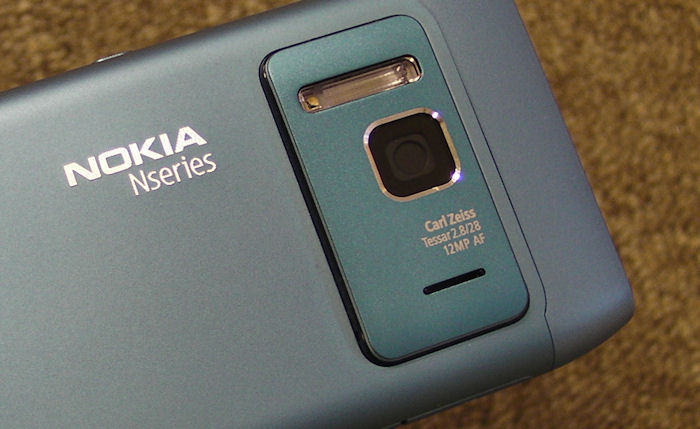
Finally, it's true that some aspects of Symbian^3 and its implementation are less intuitive and useful than the best of the competition. I'm thinking of the legacy 'left/right' function panels in many applications, the mishmash of font sizes used in some built-in applications (e.g. Nokia Social) and of the lack of multi-touch support in the on-screen qwerty keyboard - almost four years after the iPhone was announced, Symbian really should have caught up in this area by now. (There is word correction (and optional auto-completion) and this gets better and better as it learns your vocabulary, but without multi-touch you have to slow your input down to lift each finger before the next one hits somwhere else on the virtual keyboard. More on this in part 4 of our review, looking at the N8's interface in general.)
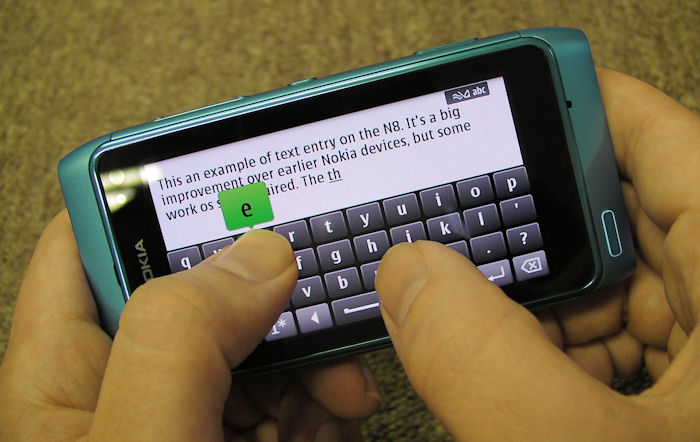
But let's not dwell on the negatives, there's simply so much that's positive about the N8 that really is worth shouting about.
We'll be talking about where the N8 fits into the increasingly competitive smartphone landscape of 2010 later, but for now let's look at it from the specific perspective of a generation of All About Symbian readers used to the likes of the Nokia 5800, N97, N97 mini and even X6:
RAM has been doubled, free RAM almost tripled. 128MB of RAM seemed enough when the likes of the 5800 and N97 were conceived, but (predictably) the OS and applications 'ran away' in terms of resource requirements and most S60 5th Edition users will have hit RAM 'memory' limits regularly. With 256MB onboard (and following the Samsung i8910 and Sony Ericsson Satio/Vivaz), there's plenty of free RAM for the running OS and applications. It has been argued that even the current 135MB of free RAM in the N8 may not be enough over the whole of the device's lifetime, but its fair to say that it's got a far better chance than the 5800 and N97 had, plus there's the added benefit of 'writeable demand paging', effectively virtual memory for the OS.
Larger system disk. As with the N97 mini, C6-00 and X6, Nokia has learnt its lesson here and is shipping the N8 with a 512MB 'system' (C:) disk, of which around 185MB is free when the device is first started. With many Nokia applications insisting on installing to disk C:, this sort of space is essential. The N8 also has a 16GB mass memory disk (of which around 14.5GB is available after purchase, partly because of sample content and partly due to the 'virtual memory'/'writeable demand paging' system used in Symbian^3), but this is, as usual, seen as disk E: (the microSD card - should you insert one - is disk F:)
Responsive touchscreen, using capacitive technology. Apart from the 3.2"-screened X6, the N8 is Nokia's first capacitive touch-driven smartphone. As I discussed in detail here, user interface expectations are now such that capacitive touch is a must. The N8's toughened glass screen offers both better mechanical protection and 'instant' response to a user's touch, with no reliance on a specific finger pressure. The downsides of capacitive technology apply (such as having to use a finger and not a stylus), but aren't really an issue for most people. As a bonus, multi-touch (first seen on the iPhone) is also implemented in a few select applications - of which more in a future review part.
Streamlined UI. As mentioned before on AAS, Symbian^3 has done away with the old 'scroll and select' UI inherited from d-pad-driven phones. On the N8, tapping an on-screen button, icon or option does something - there's no 'tap and wonder whether another tap is needed'. Where there are multiple things that you might want to do to an item (e.g. in a list), a long tap is now handled and is analagous to right clicking something in a desktop OS.
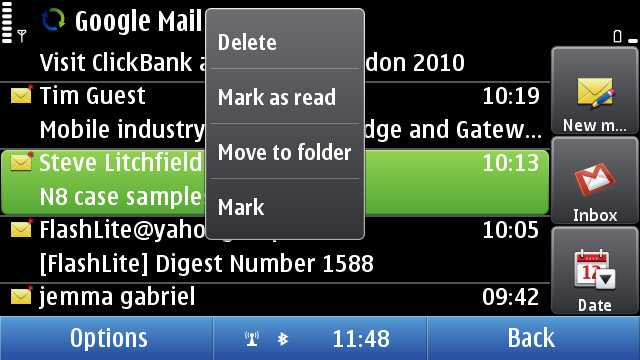
Pentaband. There's none of this 'European version, APAC version, USA version' nonsense. The N8 supports HSDPA 850/900/1700/1900/2100 out of the box, which should mean that this one phone will work at 3G (and 3.5G) speeds across most of the world.
Graphics acceleration. You only have to try and play high bitrate/resolution videos on the previous generation of Nokia's Symbian hardware to see that the phone's main processor was often worked so hard that it started to falter. And you could forget action games, there simply wasn't enough oomph under the bonnet - you'll remember my empassioned plea for Nokia to re-introduce hardware graphics acceleration? The N8, along with its sister devices in Nokia's Symbian^3 range, has full '2D/3D Graphics acceleration' (ref), meaning that videos decode easily and play smoothly, transitions animate without hiccups and action games become possible. Rally Master Pro (in the Ovi Store) seems optimised for the new platform and frame rates are silky smooth.
Three homescreens. You may think this a trivial addition - or, indeed, think it's not enough (if you're coming from, say, Android) - but, now that the idea of having widgetised homescreens is established, it makes sense to have space for more than six widgets. The idea here is to side swipe to switch screens, perhaps reserving one for media widgets, one for business things and one for shortcuts - or however you want to try organising things. Side swiping is smoothy implemented, again thanks to that capacitive touchscreen. One nice touch is that each homescreen can have its own wallpaper, for added atmosphere and distinction.
Better use of screen real estate. As mentioned above, on the S60 5th Edition phones, there are large left and right 'function'/soft keys at the bottom of each screen - or worse, in landscape mode, on the right and using up far too much room in many applications. Symbian^3 on the N8 reduces the space taken in landscape mode but the old left/right function key metaphor is still used, both in portrait and landscape mode in most cases. This is something of a waste of screen space still and has apparently been preserved to help upgraders feel familiar with the user interface. With the change in UI for Symbian^4, future devices are expected to ditch these vestigial panels completely, though we're stuck with them for the N8. In use, they're rarely an issue however.
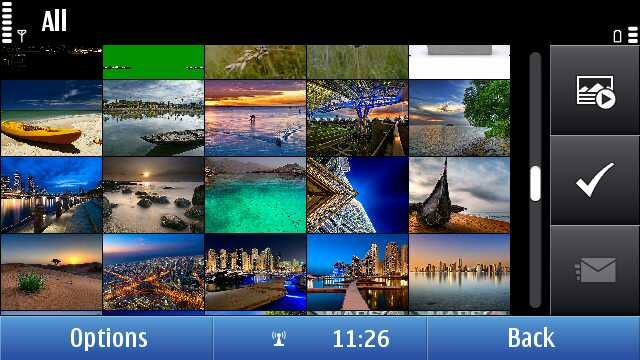
In addition to the improvements just noted, there's a distinct step-up in build quality. The N8 is essentially a unibody aluminium design (in a number of possible colours - "Dark Grey, Silver White, Green, Blue, Orange", with doubtless more to follow - a byproduct of the anodising process for the metal), measuring 113 x 59 x 13mm and weighing 135g. Nokia has demonstrated the 'scratch resistance' of the aluminium several times - together with the toughened glass on the display, it's fair to say that the N8 should come through day to day scrapes without incident.
Screen size is an interesting issue on the N8. The 3.5" AMOLED screen* is noticeably smaller than the 3.7" screen of many of the N8's rivals from the Android world (e.g. Google Nexus One, Motorola XT720, HTC Desire), and also noticeably smaller than the '3.5"' display of the Apple iPhone. Partly because the nHD screen resolution that's standard in Symbian at the moment has a natural 16:9 ratio which is slightly 'slimmer and taller', but also because the display's not really 3.5" - it's 3.46". If this seems a little picky, it's worth pointing out that the Samsung i8910 HD, also running Symbian, is narrower than the N8 and yet packs a full 3.7" display. The discrepancies are explained by the presence of an unfortunately wide bezel all around the N8 screen, in addition to the curved device sides.
The N8's display effectively matches that of the N97 for size, but utterly blows the latter away for colour and vibrancy, being AMOLED*. And 'second generation' AMOLED at that, with an anti-reflection layer beneath the glass, with the result that it's far clearer outside in sunlight than the first-gen AMOLED display on the Samsung i8910 HD. Note that this isn't the polarising technology that Nokia perfected for their imminent ClearBlack Displays (CBD), though you can see why they thought the anti-reflection concept was worth investigating further. I'd pitch the N8's display for outdoor visibility right alongside the screen in the Samsung Galaxy S (using 'Super AMOLED').
* AMOLED's other potential downside is that the display technology gradually dims over time, though in practice you'd be looking at ten years or so to get down to half brightness and you're unlikely to notice a significant difference with the naked eye over the year or two you'd own the N8.
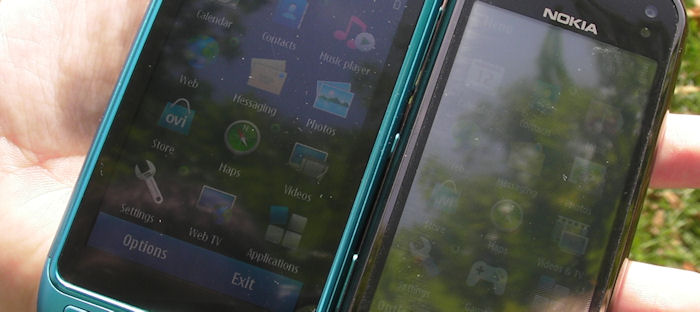
(next to the TFT-screened N97 mini)
It's also worth noting that Nokia has at last started using the ambient light sensor on its phone faces - the N8 has an auto-brightness algorithm built-in - it's a little spooky at first but after a day or so of use you simply trust it to do the right thing and are thankful for the power saving.
The issue of screen resolution has been a thorny one, with the resolutions of the flagship Android phones being typically 800 by 480 and the iPhone 4 (famously - 'retina display') 960 by 640. These numbers make Symbian's 'standard' resolution (now used on the upcoming E7, C6-01 and C7, as well as all the older touchscreen phones) seem a trifle low at 640 by 360, but I can't emphasise enough that this simply isn't an issue for most people, including me. The dots-per-inch figure is still relatively high - anyone with 20:20 eyesight may be able to spot the pixels at work, but I found 'nHD' on the N8 perfectly smooth and clear (though, as hinted above, some of the fonts used in the current firmware can sometimes be hard to read, due to their light weight and small size).
At the top and bottom of the N8 there are small plastic end caps, in theory colour matched to the main metal body but in practice you can easily see the join(!), providing aerial placement and optimisation for the multitude of RF aerials: the pentaband 3G radio (in the bottom), quad-band GSM radio (in the top), GPS receiver, FM receiver, FM transmitter, WiFi and Bluetooth - it's not clear yet where these latter aerials are, but we've had no problems so far.
The top of the N8 has the power button, HDMI-out port for connection to your digital TV (via the supplied adaptor, and including sending the audio output through with Dolby Digital Plus encoding, should you have any media with this information built-in) and a 3.5mm audio out jack:
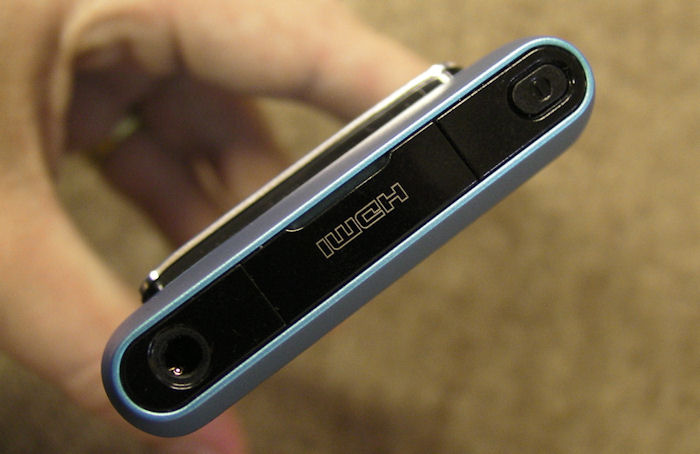
On the right of the N8, there are volume/zoom keys, the (essential) key-lock slider and a really satisfying two-stage camera capture key:
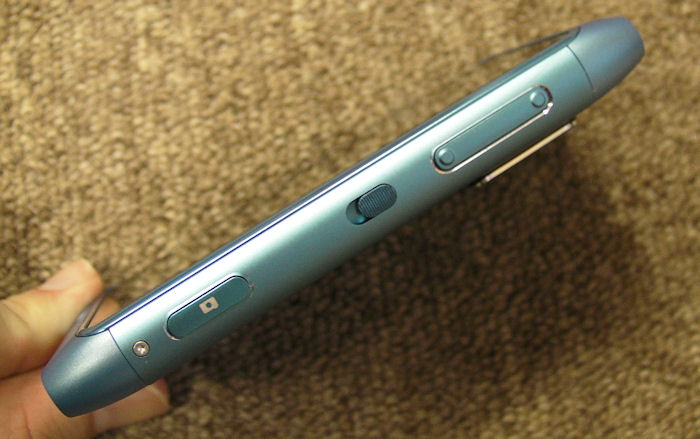
On the left side, hidden behind a plastic, flush-fitting tab, is a slot for a microSD card (particularly good to see in the light of some other Symbian^3 releases not being similarly expandable, e.g. the Nokia E7) and, behind another tab, another for the SIM card. This last has to be external because you'll remember that there's no removable battery cover - or indeed major access hatch of any kind. Further down on the left is an uncovered microUSB port for charging and data, including the new USB-on-the-Go capability, of which more in a later review part.
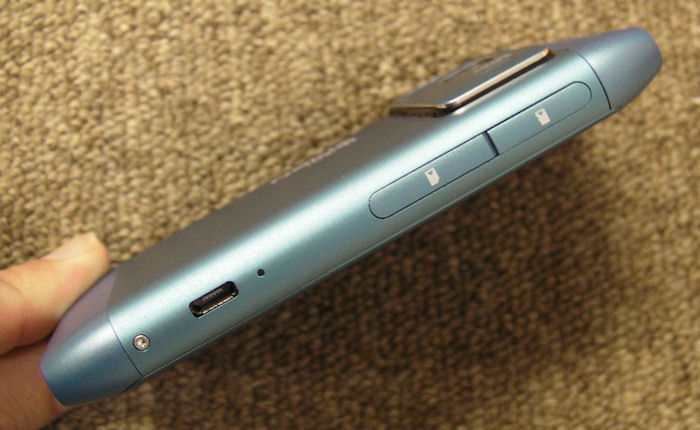
Finally, on the N8's bottom, is a traditional 2mm charging port as well - one of a number of Nokia handsets that now have dual charging options.
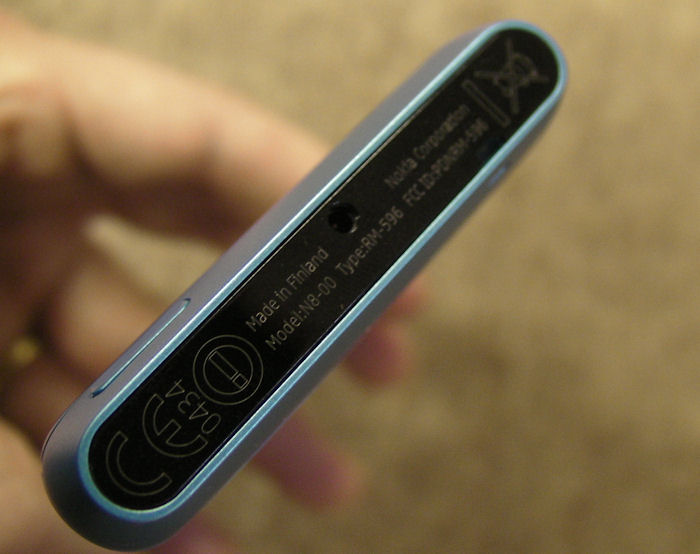
Unlike earlier Nokia Symbian^1 phones, there are no call or hangup buttons - all telephony control is now via the touchscreen. Not having buttons to control calls isn't a huge deal, though will doubtless be missed by some, and there are several third party applications - notably Google Maps/Search - that explicitly used to use the green 'call' key for major functions (e.g. voice search), so new versions will be needed in due course.
The remaining hardware button on the design's front is the Home button, feeling a little odd at first until you get used to the fact that it's on a sloping panel. Long-pressing this home button brings up the task switcher, as you might expect from the last eight years of S60 and Symbian smartphones, but it's enhanced here by showing 'live' snapshots of what each application is up to (or at least what it was up to at the instant you long pressed the button), so that you can instantly recognise which one is which. Picking an application does involve a fair amount of left/right swiping if you've got a lot open, but the novelty of seeing what all the apps are doing doesn't wear off and this is a fair compromise.
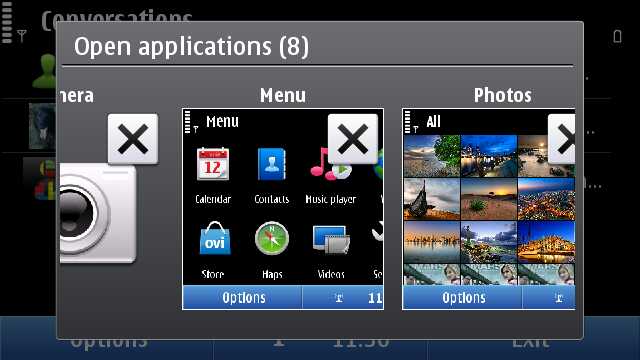
On the N8's back is, of course, the much-touted 12 megapixel camera (and rightly so - you'll remember Damian Dinning's stunning gallery a couple of weeks ago). You'll remember from my own Camera Nitty Gritty series that megapixels aren't everything, but it's easy to make an exception in this case because Nokia has designed the rest of the camera specs to match the pixel count. Here's my detailed run through the N8 camera innovations, but, in brief:
- Xenon flash - the only camera flash technology worthy of the word 'flash' - the last couple of years of poor LED-lit party shots can be safely forgotten - see my feature on this.
- Very large sensor (rated at '1/1.83"' optical format - even the previous imaging champion, the N86 only had a '1/2.3"' sensor, as have many standalone compact cameras).
- Carl Zeiss 2.8/28 optics - a mechanical protective sliding shutter for the camera glass was rejected because of bulk (another 3mm would be needed, i.e. a bigger bulge) and, interestingly, also because more and more software is requiring camera access (e.g. augmented reality) and the apps need the picture immediately.
- Extra software enhancements. With the larger sensor and better optics, there was apparently less need for Nokia's traditional noise reduction algorithms, so more processing power could be applied to real time image handling. This is evidenced by lightning fast auto-focus (of order of a tenth of a second or so in good light), with red eye reduction, and with very fast real-time face detection. We'll have more on camera performance in a future N8 review part.
- Mechanical shutter. Much has been made of this online, but perhaps slightly over-hyped, since this isn't actually anything new for Nokia. The N82, N95, N95 8GB and N86 (to name but four models) all also have great mechanical shutters in their camera units. Still, the presence of a real shutter mechanism, allied to the use (again) of an automatic ND (Neutral Density) filter that slots in when light levels are too high, does give extra confidence when trying to snap shots that are out of the ordinary, light-wise.
- Stereo audio recording in video mode, as on the original (stunning for its time) N93. There's one mike on the camera side, plus the normal one used for voice calls on the N8's face. The N93 used the stereo to construct a left/right soundscape - the N8 concentrates on applying noise cancellation algorithms, in theory reducing wind noise and also controlling the recording levels in continuous harsh noise environments.
- The microphones used are digital, i.e. the same as those used in the N86 8MP, and together with that model, produce the best sound quality of any current phone 'camcorder'.
- Focussing in video mode is 'fixed', as on the N86, with the f2.8 aperture giving, in good light, a genuine depth of field of 60cm to infinity. I've gone over the pros and cons of the various approaches to video focus in mobile phone cameras before - no focussing and you get blurry subjects; initial focus and you get blurry subjects when the composition changes; continuous auto-focus and you have to wait while focussing gets fixed whenever you change the subject. Simply having great depth of field and letting the user shoot whatever they want without needing any camera knowledge is a very valid solution. See the sample below!
- The same intelligent digital zoom in video mode as the N86 - this technology seems to be unique to Nokia - the whole 12mp sensor is used for video capture, with downscaling to the desired resolution happening in custom electronics hardware. This means that up to 3x zoom should be handled without undue pixellation (there's a 'hard' limit on the N8 at 3x, to stop people trying to zoom further and starting to see degraded results) - see below for the sample video which demonstrates this. If you don't want to use the zoom buttons, double-tapping the screen auto-zooms to 3x immediately - also demonstrated here.
Based on All About Symbian's first few days with the N8, then, here are some camera still and video samples - click through to enlarge or download any that take your fancy, to see them in their full 12 (or 9) megapixel glory (depending on aspect ratio captured - we've supplied a mix).
(the above four taken in hazy sunshine)
(these taken in heavy overcast conditions/indifferent light)
(There'll be more samples and camera comparisons in part 2 of our N8 review. Of the above images, the last was taken with the N8's Xenon flash)
Here's a test of the N8's video capture, demonstrating three of its main 'pros': smooth capture and frame rate, 'intelligent' digital zoom and high depth of field. Note that wind noise was a slight problem after all - the 'noise cancellation' routines for this didn't quite work the wonders I was expecting:
Also on the back, embedded in the camera island, is a powerful mono speaker - I'd rate it as up with one of the units in the 5800 or X6, though only being mono means there's not as much 'presence' in the room, when playing. Although the speaker aperture is flush with the camera island, sound isn't shut off when you put the N8 on a table because of the way the island props the phone at a slight angle - thankfully.
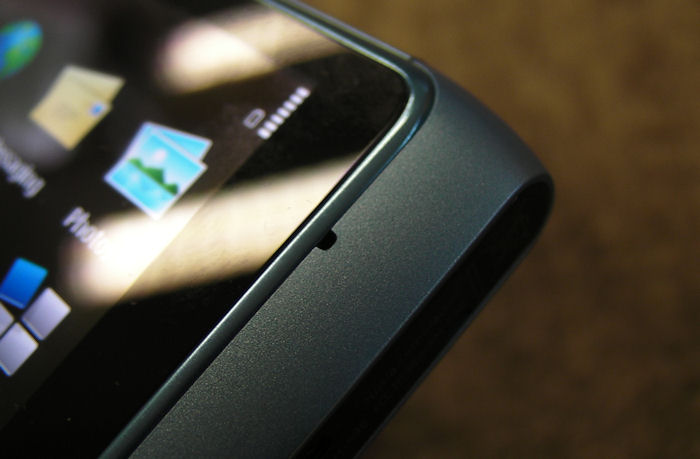
the front face microphone
When we were first handed the N97 to review, around 15 months ago, it was clear that the software wasn't 100% ready and that there were some issues. The N8 seems far more stable, in terms of multitasking and general operation, thankfully. But, regardless, there are a number of small indications that this is still early firmware and that updates will follow quickly.
Aside from minor glitches in the multi-touch in Web and an issue where 3G data was 'held' even when moving back into Wi-Fi coverage, one critical bit of basic functionality is missing - Share online is nowhere to be seen. So you can't shoot a photo or video and then send it somewhere online, at least not out of the box - a baffling omission in 2010. The same applies to Nokia Podcasting, which we'd all believed would be in the final firmware. Now, third party freeware, in this case Pixelpipe Send and Share (in the Ovi Store) and Symbian Podcatcher (install the Symbian^1 version for now, there's an issue with the S^3-optimised one) takes up the slack in these areas, but it's a shame not to have the original apps in the device from the get go and I'd hope that one or both of these will be rectified by Nokia in due course.
If you're after my very early verdict on the Nokia N8, then it's positive, with only a few caveats. If you're a bit of a camera nut like me, then don't hesitate to buy - it's stunning. If you're looking for a more rounded 2010 smartphone then you've got more to take into account - not least the rest of my/our review over the next week or two. And it's worth bearing in mind that a modern smartphone, especially on a new platform, is a complex entity and it'll take us a few weeks of intensive use to deliver a more thorough verdict.
In future review parts, Rafe and I will be looking more at daily use, application compatibility, multimedia performance, N8 new technology, plus we'll be trying out some of the N8's (and Symbian^3's) additions to the standard S60/Symbian^1 interface and function set, including the Social integration already highlighted here on AAS and the new version of the Ovi Store. And - in the fullness of time, both the upcoming new web browser and a hopefully steady stream of updates and other improvements.
Steve Litchfield, with contributions from Rafe Blandford, All About Symbian, 01 Oct 2010
Previous N8 related content highlights
The Making of the Nokia N8's camera
Rafe's video preview of the Nokia N8
Reviewed by Rafe Blandford, Steve Litchfield at


